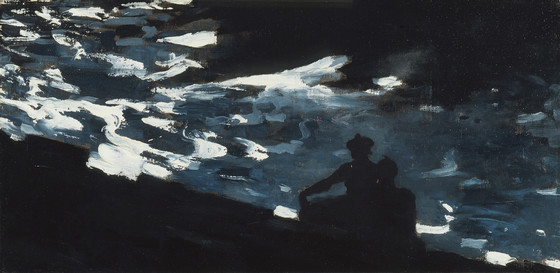While living in Cullercoats in 1881-82, Homer reinterpreted the popular image of women anxiously searching the stormy North Sea for their loved ones....
While living in Cullercoats in 1881-82, Homer reinterpreted the popular image of women anxiously searching the stormy North Sea for their loved ones. Quite unlike those heroic figures are the diminutive silhouettes in the museum’s painting, who very well may represent the summer visitors from the nearby hotels whom Homer and his family are known to have joined on at least one occasion as they watched the moonlit sea on the rocks near Homer’s home and studio at Prout’s Neck, Maine. On that occasion, the artist left the group, completing on the porch of his studio the charcoal drawing that formed the basis of his painting A Summer Night, 1890 (Musée d'Orsay, Paris), in which the figure at left in the museum’s painting seems to appear. Like the watercolor A Moonlit Sea, 1890 (Wadsworth Atheneum, Hartford), the museum’s painting may be a study for A Summer Night; or it may be an independent work of years earlier, related to the watercolor, Northeaster, dated 1883 (Brooklyn Museum), a daylight scene in which two women in tam-o’-shanter and round bonnet watch the sea from the rocks (although their positions are reversed). It can also be related to the painting Moonlight, Wood Island Light, 1894 (Metropolitan Museum of Art, New York), because of the exceptionally bold technique of both paintings. According to the art historian William Downes, that picture was painted in 1894 during an impulsive four or five hours’ work one night, entirely by moonlight, a seemingly impossible illumination for judging colors. Because of its exceptionally free technique, the museum’s painting is difficult to date on the basis of style. The connection with the works of 1890 seems most persuasive. For Homer, the moonlit sea was a recurring romantic theme in which the otherwise threatening sea seems tamed and charmed. The violence of the sea in Moonlight on the Water is somewhat unusual within this group.
On the back of the painting the artist’s brother Charles, his executor, indicated the date 1906, a period when Homer was known to have begun no new pictures, only repainting old ones. While there is no evidence of repainting on the picture’s present surface, it may have been at this time that Homer restretched the painting, greatly changing its proportions by folding portions of the painting back around the stretcher at the top and sides to give it its present, unusually elongated shape. In adopting this format, Homer may have meant to accentuate the characteristics of the painting that relate to the Japanese prints he admired -- the theme of the great wave, diagonal compositional elements, silhouetted figures, and strong surface design.
More...



